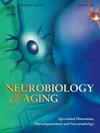Exploring the links among brain iron accumulation, cognitive performance, and dietary intake in older adults: A longitudinal MRI study
IF 3.7
3区 医学
Q2 GERIATRICS & GERONTOLOGY
引用次数: 0
Abstract
This study evaluated longitudinal brain iron accumulation in older adults, its association with cognition, and the role of specific nutrients in mitigating iron accumulation. MRI-based, quantitative susceptibility mapping estimates of brain iron concentration were acquired from seventy-two healthy older adults (47 women, ages 60–86) at a baseline timepoint (TP1) and a follow-up timepoint (TP2) 2.5–3.0 years later. Dietary intake was evaluated at baseline using a validated questionnaire. Cognitive performance was assessed at TP2 using the uniform data set (Version 3) neuropsychological tests of episodic memory (MEM) and executive function (EF). Voxel-wise, linear mixed-effects models, adjusted for longitudinal gray matter volume alterations, age, and several non-dietary lifestyle factors revealed brain iron accumulation in multiple subcortical and cortical brain regions, which was negatively associated with both MEM and EF performance at T2. However, consumption of specific dietary nutrients at TP1 was associated with reduced brain iron accumulation. Our study provides a map of brain regions showing iron accumulation in older adults over a short 2.5-year follow-up and indicates that certain dietary nutrients may slow brain iron accumulation.
探索老年人脑铁积累、认知能力和饮食摄入之间的联系:磁共振成像纵向研究
这项研究评估了老年人大脑铁的纵向积累、其与认知能力的关系以及特定营养素在减轻铁积累方面的作用。在基线时间点(TP1)和 2.5-3.0 年后的随访时间点(TP2),对 72 名健康老年人(47 名女性,年龄在 60-86 岁之间)进行了基于磁共振成像的脑铁浓度定量易感图评估。在基线时间点使用有效问卷对饮食摄入量进行评估。在 TP2 阶段,采用统一数据集(第 3 版)神经心理学测试对认知能力进行评估,测试内容包括外显记忆 (MEM) 和执行功能 (EF)。经纵向灰质体积变化、年龄和几种非膳食生活方式因素调整的体素线性混合效应模型显示,大脑皮质下和皮质多个区域的脑铁积累与 T2 阶段的 MEM 和 EF 表现呈负相关。然而,在TP1阶段摄入特定的膳食营养素与脑铁积累的减少有关。我们的研究提供了一幅在短短2.5年随访期间显示老年人铁积累的大脑区域图,并表明某些膳食营养素可能会减缓大脑铁的积累。
本文章由计算机程序翻译,如有差异,请以英文原文为准。
求助全文
约1分钟内获得全文
求助全文
来源期刊

Neurobiology of Aging
医学-老年医学
CiteScore
8.40
自引率
2.40%
发文量
225
审稿时长
67 days
期刊介绍:
Neurobiology of Aging publishes the results of studies in behavior, biochemistry, cell biology, endocrinology, molecular biology, morphology, neurology, neuropathology, pharmacology, physiology and protein chemistry in which the primary emphasis involves mechanisms of nervous system changes with age or diseases associated with age. Reviews and primary research articles are included, occasionally accompanied by open peer commentary. Letters to the Editor and brief communications are also acceptable. Brief reports of highly time-sensitive material are usually treated as rapid communications in which case editorial review is completed within six weeks and publication scheduled for the next available issue.
 求助内容:
求助内容: 应助结果提醒方式:
应助结果提醒方式:


